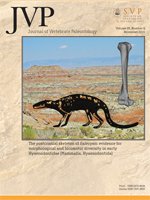Pelagornithids or bony-toothed birds were an enigmatic group of very large marine birds that existed throughout most of the Tertiary, with remains recovered in all continents. The currently recognized record of pelagornithids in South America extends from the middle Miocene to the Pliocene. Here, a fragment of a ramus mandibulae recently discovered in the Cerro La Cruz site (Castillo Formation, Lara State, northwestern Venezuela), is assigned to Pelagornis. With an early Miocene age (18.27–18.85 Ma), the fossil constitutes the earliest unequivocal record of the group in South America. The reexamination of another pelagornithid specimen recovered from Capadare Formation (middle Miocene), which was previously assigned to Pelagornithidae indeterminate, allows us to recognize the presence during the Miocene of Venezuela of a second pelagornithid morphotype, here tentatively referred to Pelagornis chilensis Mayr and Rubilar-Rogers, 2010. Originally recorded from the middle Miocene-early Pliocene of Chile, the possible presence of P. cf. P. chilensis during the middle Miocene of Venezuela might represent the first record of this bony-toothed species outside Chile and expands its distribution area by 3500 km, to the tropical waters of northern South America.
How to translate text using browser tools
1 November 2015
The Earliest Record (Early Miocene) of a Bony-Toothed Bird from South America and a Reexamination of Venezuelan Pelagornithids
Andrés Solórzano,
Ascanio D. Rincón
ACCESS THE FULL ARTICLE





